

How to Get Started Teaching Literary Analysis to High School Students. I remember my first experience teaching analysis to high schoolers.

After briefly explaining how analysis differed from summary, I asked my students to analyze the carousel scene at the end of The Catcher in the Rye. While they took several minutes to read over their annotations, I eagerly waited for their brilliant discussion of this poignant moment, knowing that I’d hear at least one student make the connection between Holden’s fixation with the carousel and his fear of growing up; perhaps one student might even cleverly conclude that the carousel, in its predictable and circular movement, offers Holden an escape from the linear inevitability of life. Instead, I received answers like this: “Holden clearly enjoys listening to Phoebe’s ride on the carousel. Novel HyperDocs: 25 ready to use units for your class - Ditch That Textbook. Novel HyperDocs are the brainchild of Heather Marshall when, after discovering HyperDocs (created byLisa Highfill, Kelly Hilton, and Sarah Landis), she decided to ditch the whole class novel and create interactive HyperDocs filled with paired texts, engaging media and interactive activities.
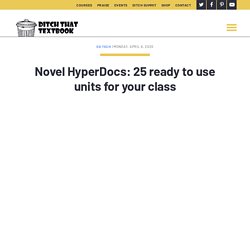
Back in 2015, Heather shared her Novel HyperDoc for The One and Only Ivan which she created for her middle school English students. She shared this amazing resource for free through Twitter using the hashtag #TsGiveTs which promotes and supports teachers sharing resources with one another for free. Since then many others, including myself, have created and shared novel HyperDocs to use with grades ranging from 2-12. Why would anyone shiver their timbers? Here’s how pirate words arrr preserving old language. There’s no shortage of special days throughout the year.
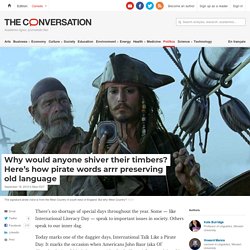
Some — like International Literacy Day — speak to important issues in society. Others speak to our inner dag. Today marks one of the daggier days, International Talk Like a Pirate Day. It marks the occasion when Americans John Baur (aka Ol’ Chumbucket) and Mark Summers (aka Cap’n Slappy) first proclaimed in 1995 that everyone in the world should talk like a pirate.
Read more: The prosecution of pirates was a model for today's system of international justice And so we thought we’d take the chance to answer a few pirate questions. Let’s get underway me language-loving ‘earties. Who put the ‘arrr’ in pirate? The modern-day fiction of pirate-speak emerged from pirate-themed amusement rides, books and films, especially the Disney classics like Treasure Island, the Pirates of the Caribbean series — and of course Australia’s own Captain Feathersword of the Wiggles fame. Unit 1: Teach Narrative Writing With The New York Times. Welcome to our first writing unit of the school year.
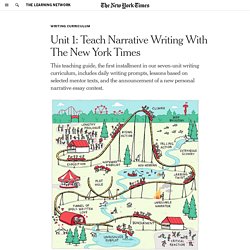
Below you’ll find a detailed description of each element, as well as ways to put them together to make your own custom writing unit. To learn more about other writing units, visit our writing curriculum overview. Stories can thrill, wound, delight, uplift and teach. Telling a story vividly and powerfully is a vital skill that is deeply valued across all cultures, past and present — and narrative writing is, of course, a key genre for literacy instruction at every level. When your students think “New York Times,” they probably think of our 168-year history of award-winning journalism, and may not even realize that The Times today is full of personal narratives — on love and family, but also on how we relate to animals, live with disabilities or navigate anxiety.
At The Learning Network, we’ve been posting writing prompts every school day for over a decade now, and many of them invite personal narrative. Here’s how it works. 1. 2. Journaling as a means to scaffold & assess learning. Journaling is like whispering to one’s self and listening at the same time.Mina Murray In an earlier post, I discussed formative and summative assessments, and how they can provide opportunities to support learners.
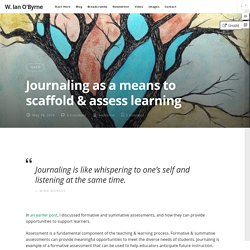
Assessment is a fundamental component of the teaching & learning process. Formative & summative assessments can provide meaningful opportunities to meet the diverse needs of students. Journaling is example of a formative assessment that can be used to help educators anticipate future instruction. What is journaling? Journaling can mean a variety of processes and habits for people in different fields. From an educational perspective, I view journaling as a tool to promote reflection, and document learning experiences. I define journaling as opportunities for individuals to document their thinking over time.
This is a series of data points that document the learner’s practices, perceptions, & processes as they build to full comprehension as a lifelong learner. Writing Historical Fiction: Collaborating to Meet the Standards. Over the past few semesters I have had the pleasure of collaborating with creative writing teachers in my building for weekly “Library Wednesday” lessons.
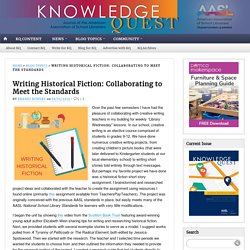
In our school, creative writing is an elective course comprised of students in grades 9-12. We have done numerous creative writing projects, from creating children’s picture books (that were later delivered to Kindergarten students at our local elementary school) to writing short stories told entirely through text messages. But perhaps my favorite project we have done was a historical fiction short story assignment.
I brainstormed and researched project ideas and collaborated with the teacher to create the assignment using resources I found online (primarily this assignment available from TeachersPayTeachers). The project was originally conceived with the previous AASL standards in place, but easily meets many of the AASL National School Library Standards for learners with very little modifications. Like this: "bearer" on Visuwords™ How to use AustLit Trails: for teachers. What is AustLit?

AustLit is a fantastic resource that makes the lives of researchers, students of literature and especially teachers easier. MyShakespeare.